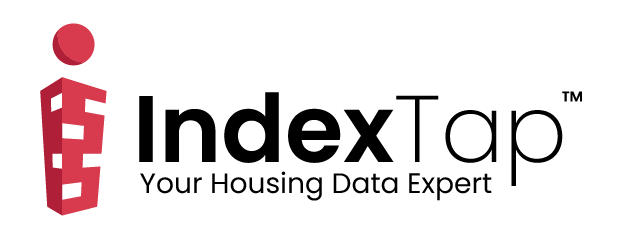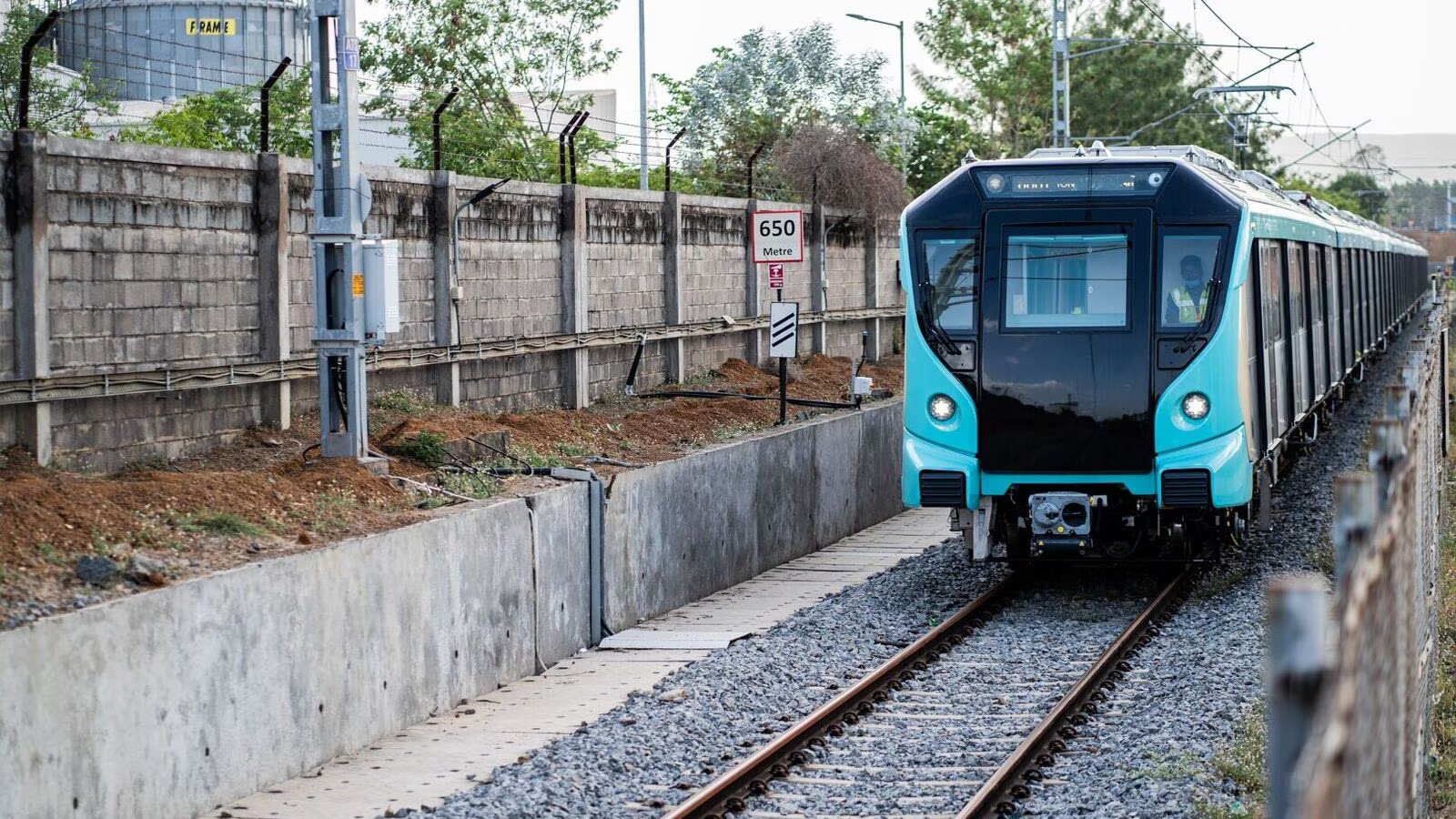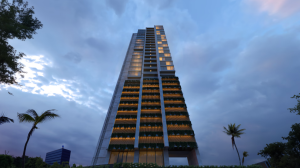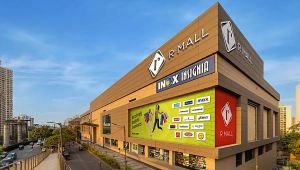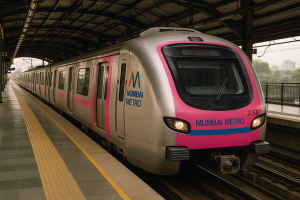Mumbai Metro Line 3 stretches 33.5 kilometres from Cuffe Parade to Aarey Colony. Its BKC to Worli stretch will open in late 2024, and the Aarey Colony to BKC stretch is expected to be completed by the end of July 2024.
An Overview of Mumbai Metro Line 3
Every year, people from all walks of life relocate to Mumbai in search of better opportunities. The city of dreams has unparalleled travel connectivity, thanks to its excellent highways and Mumbai Metro. The Mumbai Metro Line 3 is the latest addition to the city’s rapidly expanding metro network. It is also known as the Mumbai Metro Aqua Line and the Colaba-Bandra-SEEPZ Line. Metro Line 3 will be 33.5 kilometres long when completed, with 27 stations stretching from Cuffe Parade to Aarey Colony.
Mumbai-Metro Line 3 will be operated by the MMRC (Mumbai Metro Rail Corporation Limited) and will primarily be an underground line. The project was announced as a 50:50 joint venture between the GOI (Government of India) and the GOM (Government of Maharashtra). The metro line’s construction plan was approved in 2018 for a cost of Rs 23,136 crore.
JICA (Japan International Cooperation Agency) is financing the majority of the project, 57.2%, through an ODA loan of Rs. 13,235 crores with a 30-year repayment period, 1.15% interest rate for project activities, and 0.01% interest rate for consulting services.
While the Metro Line 3 is frequently in the news due to construction delays and protests, many people are still unaware of the specifics surrounding it. Scroll down for all the details, including a route map, system specifications, ticket prices, and construction status.
Opening Status of Mumbai Metro Line 3
The first phase of Mumbai Metro Line 3, also known as the Aqua Line, is expected to be operational shortly.
The first phase of the Aarey to BKC route is expected to open to the public in May 2024.
MMRC intends to launch metro services between BKC (Bandra Kurla Complex) and Worli in the second half of 2024.
The services will be operational on a 9.63-kilometer stretch of Mumbai Metro Line 3 after phase 1 from Aarey Colony to BKC opens at the end of May.
The MMRC has decided to begin services along this stretch rather than waiting for Phase 2 between BKC and Cuffe Parade to be completed.
The second phase of the BKC-Colaba Metro-3 line will be completed by October 2024. The entire route is expected to serve 17 lakh passengers per day.
The work on phase one of Mumbai Metro Line 3 between Aarey and BKC stations is 96% complete. The remaining 4% will be completed shortly.
MMRC plans to open the entire 33.5-kilometer Metro-3 corridor by the end of 2024.
Key Facts of Mumbai Metro Line 3
| Name of Mumbai Metro Line 3 | Aqua Line |
| Estimated Cost | Rs 23, 136 crores |
| ODA Loan | JICA of Rs. 13,235 crore |
| Length | 33.5 km |
| Type | Underground and At-Grade |
| Number of Stations | 27 |
| Estimated Ridership | 17 Lakhs per day |
| Status | Under Construction |
Route Map of Mumbai Metro Line 3
The Mumbai Metro Line 3 is intended to make commuting easier for passengers. It has eight connections with railways, MSRTC (Maharashtra State Road Transport Corporation), and Metro Lines 2B and 1. It is Mumbai’s first and only fully underground Metro corridor, with 26 of 27 underground stations.
Mumbai Metro Line 3 Stations
The following is a list of Mumbai Metro Line 3 stations, ranging from Aarey Colony to Cuffe Parade.
| S. No | Mumbai Metro Line 3 Station | Station Layout | Opening Date |
| 1 | Aarey Colony | At-Grade | Dec 2023 |
| 2 | SEEPZ | Underground | Dec 2023 |
| 3 | MIDC | Underground | Dec 2023 |
| 4 | Marol Naka | Underground | Dec 2023 |
| 5 | CSMIA T2 | Underground | Dec 2023 |
| 6 | Sahar Road | Underground | Dec 2023 |
| 7 | CSMIA T1 | Underground | Dec 2023 |
| 8 | Santacruz | Underground | Dec 2023 |
| 9 | Vidyanagri | Underground | Dec 2023 |
| 10 | BKC (Bandra Kurla Complex) | Underground | Dec 2023 |
| 11 | Dharavi | Underground | TBA |
| 12 | Shitladevi Temple | Underground | TBA |
| 13 | Dadar | Underground | TBA |
| 14 | Siddhivinayak Temple | Underground | TBA |
| 15 | Worli | Underground | TBA |
| 16 | Acharya Atrey Chowk | Underground | TBA |
| 17 | Science Museum | Underground | TBA |
| 18 | Mahalaxmi | Underground | TBA |
| 19 | Mumbai Central | Underground | TBA |
| 20 | Grant Road | Underground | TBA |
| 21 | Girgaon | Underground | TBA |
| 22 | Kalbadevi | Underground | TBA |
| 23 | Chhatrapati Shivaji Maharaj Terminus | Underground | TBA |
| 24 | Hutatma Chowk | Underground | TBA |
| 25 | Churchgate | Underground | TBA |
| 26 | Vidhan Bhavan | Underground | TBA |
| 27 | Cuffe Parade | Underground | TBA |
Interchange stations along the Mumbai Metro Aqua Line
In the 27-station route map of the Mumbai Metro Aqua Line 3, passengers can connect to other metro lines or railways via multiple interchange stations. This includes:
The SEEPZ (Santacruz Electronic Export Processing Zone) station connects to the Mumbai Metro Line 6.
The Churchgate Metro Station connects passengers to the Western Line (Mumbai Suburban Railway).
Marol Naka Metro Station connects to the Mumbai Metro Blue Line 1.
Mumbai Central Metro stations connect to the National Rail Network and the Western Line (Mumbai Suburban Railway).
The CSMIA T2 (Chhatrapati Shivaji Maharaj International Airport, Terminal 2) Metro station connects to the Mumbai Metro Red Line 7.
The Mahalaxmi metro station is also connected to the Western Line (Mumbai Suburban Railway) and the Mumbai Monorail.
The CSMT metro station connects to three different lines. It includes the National Rail Network, as well as the Mumbai Suburban Railway’s Central and Harbour Lines.
The Marol Naka metro station connects to Mumbai’s Metro Line 1
The BKC (Bandra Kurla Complex) metro station connects to Mumbai Metro Line 2.
Mumbai Metro Line 3 Ticket Fare Collection
There has been no announcement about the fare structure for Mumbai Metro Line 3. However, the MMRCL will use an open-loop automated fare collection (AFC) system. This means that passengers will be able to make contactless post-paid and pre-paid payments using smart cards. They will also be able to pay for tickets via QR codes on their smartphones.
Extension of Mumbai Metro Line 3
Mumbai Metro 3 will extend the underground corridor up to Navy Nagar, Colaba.
The Mumbai Metro Rail Corporation (MMRC) intends to extend the Mumbai Metro 3 underground corridor to Navy Nagar in Colaba. This extension proposal covers 2.5 kilometres and would take 30 months to complete. Here are the main details:
The proposed underground extension will include four additional stabling lines to increase Metro capacity.
The extension would expand the 33.5 kilometres long Mumbai Metro 3 corridor from Cuffe Parade to Aarey, passing through BKC (Bandra Kurla Complex).
It would begin at the proposed Navy Nagar station and extend an additional 1 km for the train reversal facility, which would allow movement from the Up to Down line tracks.
The Navy, which has approximately 1 lakh residents, including a floating population in Navy Nagar, has expressed interest in this project.
The MMRC board approved the project, and the implementation authority completed a detailed project report (DPR) for the extension.
Infrastructure of Mumbai Metro Line 3
In September 2018, the MMRC awarded a EUR 315 million contract to Alstom Transport (a French transportation company) and its Indian subsidiary to supply 336 coaches for Mumbai’s Colaba-Bandra-SEEPZ Line. According to the contract, the agency will manufacture, design, supply, install, and test the train sets. The trains will seat approximately 300 passengers in each coach, for a total seating capacity of 3,000.
Interestingly, Mumbai Metro Line 3 has a Grade 4 automation level, indicating that it will be driverless. However, during its first year of operation, MMRC will hire drivers.
Mumbai’s Metro Line 3 will use the Alstom Urbalis 400 CBTC (Communications Based Train Control) signalling system.
Features of Mumbai Metro Line 3
DMRC and MMRC manage Line 3 of Mumbai Metro, which runs from Colaba to SEEPZ. DMRC was awarded a 10-year contract after a global competitive bidding process in which it emerged as the lowest successful bidder.
DMRC will manage the underground line’s day-to-day operations, including train operation and maintenance, system infrastructure, and passenger safety.
MMRC, on the other hand, is developing the line and will be in charge of revenue management, non-fare box revenue generation, and legal compliance.
Emergency Doors at Both Ends: The Mumbai Metro Rail Corporation (MMRC) has decided to add emergency doors to trains on Mumbai Metro line 3. In the event of an emergency, the emergency doors on both ends will allow passengers to exit safely. Such metro trains are ideal for underground sections. In India, two types of evacuation systems are currently used: side evacuation and through normal doors.
Driverless Operations: Once Phase 1 (Bandra Kurla Complex to Aarey) is completed, Mumbai’s first underground metro line will seek safety approval to begin driverless operations. A six-month trial is required to obtain a CMRS clearance for driverless operations. Once approved, MMRC will transition to driverless operations.
Uninterrupted Mobile Connectivity: Because the Mumbai Metro Line 3 is entirely underground, maintaining a mobile network is difficult. To address this issue, MMRC intends to deploy cellular coverage from mobile service providers including Airtel, Jio, Vodafone, and MTNL. This will be accomplished through in-building solutions that place antennas and repeaters within underground stations and tunnels.
Exceptional Capacity: The trains on Line 3 of the Mumbai Metro will be able to transport 3,000 passengers at once. It is designed for PHPDT (Peak Hour Peak Direction Traffic), which carries approximately 72,000 passengers.
All trains will be fully air-conditioned and equipped with a CBTC (Communication-Based Train Control) signalling system for driverless operation.
Mumbai Metro Line 3’s Impact on Real Estate
The Colaba-Bandra-SEEPZ Line is expected to transform Mumbai’s real estate landscape. Since construction on Aqua Line 3 began in 2017, numerous developers have expressed interest in projects along its routes. Five years later, in 2023, there was an upward trend in property and project prices near these routes.
With the first phase of Mumbai Metro Line 3 set to open in December 2023, a variety of micromarkets will likely benefit. This includes the CBD (Central Business District), SBD (Secondary Business District), and the North, West, and Eastern suburbs.
According to experts, once the Aqua Line is operational, the prices of residential properties in Navi Mumbai and Thane will rise. It will significantly improve connectivity with the commercial hubs in the north of SBD.North and the West
Latest News and Updates on Mumbai Metro Line 3.
Phase 1 of Mumbai Metro Line 3 is ready for operations beginning December 2024.
On June 24, 2024, Mumbai Metro Rail Corporation Limited (MMRCL) announced that the construction of Aarey Depot is 99.5 percent complete. The first phase of Metro Line 3 is expected to be operational by December 2024.
With the first underground metro line set to open to the public in December, traffic congestion is expected to significantly improve. The Mumbai Metro Line 3, which is also the city’s first underground metro, is 33.5 kilometres long and includes 27 stations, 26 of them underground. The Mumbai Metro Rail Corporation has invested Rs 37,00 crores in this ambitious project.
Check Out Properties near Mumbai Metro Line 3
The metro will operate 260 services per day, with one metro every few minutes between 6:30 a.m. and 11:00 p.m. Commuters can expect to save a significant amount of time traveling on Mumbai Metro Line 3 compared to the roads. The metro can reach speeds of up to 90 km/h, reducing travel time to 50 minutes compared to two hours by road.
Summing up: Mumbai Metro Line 3.
Like the other Mumbai Metro lines, the Aqua Line Metro (Line 3) will improve city connectivity and reduce passenger travel time. It will connect Mumbai’s southern and western suburbs via an underground corridor. When completed, it will remove nearly 7 lakh vehicles from the road, alleviating massive congestion and traffic in the city.
